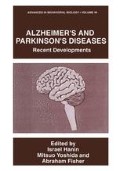Abstract
Mammalian cells can process the Amyloid Precursor Protein (APP) by two alternative physiological pathways: one that can be defined “amyloidogenic” since cleavage occurs in the endosomal-lysosomal compartment to generate the entire ßA4 peptide sequence; the second which is “non-amyloidogenic” and involves the secretory cleavage of APP at a site within the (3A4 sequence (for a review see Selkoe, D.J., 1993). Since APP metabolism may become disrupted in both the idiopatic and transmissible forms of the disease, in vitro studies on the processing of endogenous or transfected APP molecules have emerged as major experimental endeavours in the past few years. But ß amyloid formation may not only depend on APP mismetabolism. It is feasable that the pathogenetic mechanisms of amyloid formation may involve changes in APP gene expression as a required step. Several observations underscore the potential contribution of APP gene overexpression to Alzheimer’s disease neuropathology: 1) in trisomy 21 (Down Syndrome) there seems to be a deregulated expression of APP since the difference in APP mRNA levels between patients and controls is higher than the expected 3:2 ratio (Neve et al., 1988; Tanzi et al., 1987); 2) there are differences between AD patients and controls in the levels of APP mRNAs in certain brain areas (Higgins et al., 1988; Cohen et al., 1988; Johnson et al., 1990); and 3) post-mitotic neurons overexpressing full-length APP degenerate in vitro and contain large amounts of amyloidogenic C-terminal fragments (Yoshikawa et al.,1992). These observations demonstrate the importance of elucidating the molecular mechanisms of APP gene regulation, in other words of identifying in the 5’ regulatory region cis-elements and transcription factors relevant for gene expression. APP overexpression may indeed result from imbalance between regulatory pathways for APP expression (alterations in transcription factors expression/activation) or mutations in the APP regulatory region. The APP gene promoter has been cloned (Salbaum et al.,1988) and shown to display the characteristics of a “housekeeping gene” since it lacks a canonical TATA box, has a high GC content and transcription initiates at multiple sites. Furthermore it has been proved that this region promotes neuro-specific expression of a LacZ reporter gene in transgenic mice (Wirak et al., 1991). Several groups have proposed that the APP 5’ region contains consensus sequences for several known transcription factors. In particular binding sites for the following regulatory proteins have been described: AP1, AP4, SP1, Hox1.3, AP2, and Heat Shock Proteins (Lahiri et al. 1991; Goldgaber et al., 1989; Pollwein et al., 1991; Quitscke et al., 1992).
Access this chapter
Tax calculation will be finalised at checkout
Purchases are for personal use only
Preview
Unable to display preview. Download preview PDF.
References
Cohen, M.L., Golde, T.E., Usiak, M.F., Younkin, L.H., and Younkin, S.G., 1988, In situ hybridization of nucleus basalis neurons shows increased ß-amyloid mRNA in Alzheimer disease, Proc. Natl. Acad. Sci. U.S.A. 85: 1227–1231.
Goldgaber, D., Harris, H.W., Hla, T., Maciag, T., Donnelly, R.J., Jacobsen, J.S., Vitek, M.P., and Gajdusek, D.C., 1989, Interleukin 1 regulates synthesis of amyloid b-protein precursor mRNA in human endothelial cells, Proc. Natl. Acad. Sci. U.S.A. 86: 7606–7610.
Grilli, M., Chiu, J.J-S., and Lenardo M.J., 1993, NFkB and Rel:participants in a multiform transcriptional regulatory system, Int. Rev. Cyt. 143: 1–62.
Higgins, G.A., Lewis, D.A., Bahmanyar, S., Goldgaber, D., Gajdusek, C.D., Young, W.G., Morrison, J.H., and Wilson, M.C., 1988, Differential regulation of amyloid ß protein mRNA expression within hippocampal neuronal subpopulations in Alzheimer disease, Proc. Natl. Acad. Sci. U.S.A. 85: 1297 1301.
Johnson, S.A., McNeill, T., Cordell, B., and Finch, C.E., 1990, Relation of neuronal APP-751/APP-695 mRNA ratio and neuritic plaque density in Alzheimer’s disease, Science 248: 854–856.
Kang, S.-M., Tran, A.-C., Grilli, M., and Lenardo, M.J., 1992, NFkB subunit regulation in nontrasformed CD4+ T lymphocytes, Science 256: 1452–1456.
Lahiri, D.K. and Robakis, N.K., 1991, The promoter activity of the gene encoding Alzheimer ß-amyloid precursor protein (APP) is regulated by two blocks of upstream sequences, Mol. Brain Res. 9: 253–257.
Luckow, B., and Schutz G, 1987, CAT constructions with multiple unique restriction sites for the functional analysis of eukaryotic promoters and regulatory elements, Nucleic Acids Res. 15: 5490.
Neve, R.L., Finch, E.A., and Dawes, L.R., 1988, Expression of the Alzheimer amyloid protein gene transcripts in the human brain, Neuron, 1: 669–677.
Pollwein, P., Masters, C.L., and Beyreuther, K., 1991, The expression of the amyloid precursor protein (APP) is regulated by two GC-elements in the promoter, N.A.R. 20: 63–68.
Quitschke, W.W., and Goldgaber, D., 1992, The amyloid ft-protein precursor promoter, J. Biol. Cohen. 267: 17362–17368.
Salbaum, J.M., Weidemann, A., Lemaire, H-G., Masters, C.L., and Beyreuther, K. 1992, The promoter of Alzheimer’s disease amyloid A4 precursor gene, EMBO J. 7: 2807–2813.
Selkoe, D.J., 1993, Physiological production of the ß-amyloid protein and the mechanism of Alzheimer’s disease, TINS, 16: 403–409.
Tanzi, R.E., St. George,-Hyslop, P.H., Haines, J.L, Polinsky, R.J., Nee, L., Foncin, J-F, Neve, R.L., McClatchey, A.I., Conneally, P.M., and Gusella, J.F., 1987, The genetic defect in familial Alzheimer’s diseAse is not tightly linked to the amyloid ft-protein gene, Nature 329: 156–157.
Wirak, D.O., Bayney, R., Kundel, C.A., Lee, A., Scangos, G.A., Trapp, B.D., and Unterbeck A.J.,1991, Regulatory region of amyloid precursor protein (APP) gene promotes neuron-specific gene expression in the CNS of transgenic mice, EMBO J. 10: 289.
Yoshikawa, K., Aizawa,T., and Hayashi Y. 1992, Degeneration in vitro of post-mitotic neurons overexpressing the Alzheimer amyloid protein precursor, Nature 359: 64.
Author information
Authors and Affiliations
Editor information
Editors and Affiliations
Rights and permissions
Copyright information
© 1995 Springer Science+Business Media New York
About this chapter
Cite this chapter
Grilli, M., Ribola, M., Alberici, A., Valerio, A., Memo, M., Spano, P. (1995). Amyloid Precursor Protein (APP) Gene Expression is Controlled by a NFkB/Rel Related Protein. In: Hanin, I., Yoshida, M., Fisher, A. (eds) Alzheimer’s and Parkinson’s Diseases. Advances in Behavioral Biology, vol 44. Springer, Boston, MA. https://doi.org/10.1007/978-1-4757-9145-7_17
Download citation
DOI: https://doi.org/10.1007/978-1-4757-9145-7_17
Publisher Name: Springer, Boston, MA
Print ISBN: 978-1-4757-9147-1
Online ISBN: 978-1-4757-9145-7
eBook Packages: Springer Book Archive

